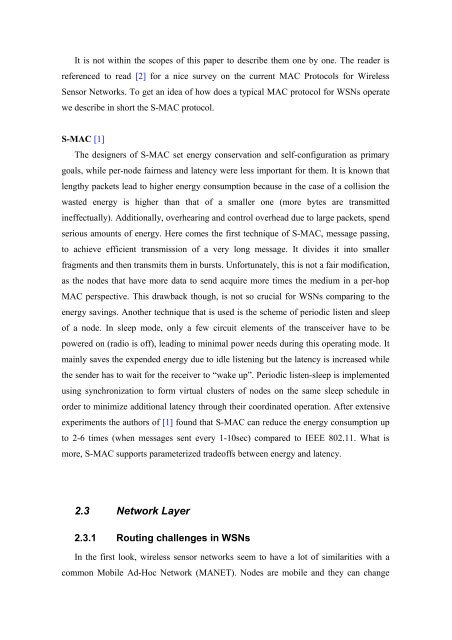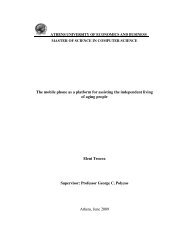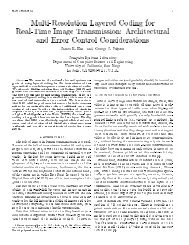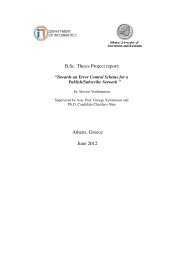In Network Processing and Data Aggregation in
In Network Processing and Data Aggregation in
In Network Processing and Data Aggregation in
Create successful ePaper yourself
Turn your PDF publications into a flip-book with our unique Google optimized e-Paper software.
It is not with<strong>in</strong> the scopes of this paper to describe them one by one. The reader isreferenced to read [2] for a nice survey on the current MAC Protocols for WirelessSensor <strong>Network</strong>s. To get an idea of how does a typical MAC protocol for WSNs operatewe describe <strong>in</strong> short the S-MAC protocol.S-MAC [1]The designers of S-MAC set energy conservation <strong>and</strong> self-configuration as primarygoals, while per-node fairness <strong>and</strong> latency were less important for them. It is known thatlengthy packets lead to higher energy consumption because <strong>in</strong> the case of a collision thewasted energy is higher than that of a smaller one (more bytes are transmitted<strong>in</strong>effectually). Additionally, overhear<strong>in</strong>g <strong>and</strong> control overhead due to large packets, spendserious amounts of energy. Here comes the first technique of S-MAC, message pass<strong>in</strong>g,to achieve efficient transmission of a very long message. It divides it <strong>in</strong>to smallerfragments <strong>and</strong> then transmits them <strong>in</strong> bursts. Unfortunately, this is not a fair modification,as the nodes that have more data to send acquire more times the medium <strong>in</strong> a per-hopMAC perspective. This drawback though, is not so crucial for WSNs compar<strong>in</strong>g to theenergy sav<strong>in</strong>gs. Another technique that is used is the scheme of periodic listen <strong>and</strong> sleepof a node. <strong>In</strong> sleep mode, only a few circuit elements of the transceiver have to bepowered on (radio is off), lead<strong>in</strong>g to m<strong>in</strong>imal power needs dur<strong>in</strong>g this operat<strong>in</strong>g mode. Itma<strong>in</strong>ly saves the expended energy due to idle listen<strong>in</strong>g but the latency is <strong>in</strong>creased whilethe sender has to wait for the receiver to “wake up”. Periodic listen-sleep is implementedus<strong>in</strong>g synchronization to form virtual clusters of nodes on the same sleep schedule <strong>in</strong>order to m<strong>in</strong>imize additional latency through their coord<strong>in</strong>ated operation. After extensiveexperiments the authors of [1] found that S-MAC can reduce the energy consumption upto 2-6 times (when messages sent every 1-10sec) compared to IEEE 802.11. What ismore, S-MAC supports parameterized tradeoffs between energy <strong>and</strong> latency.2.3 <strong>Network</strong> Layer2.3.1 Rout<strong>in</strong>g challenges <strong>in</strong> WSNs<strong>In</strong> the first look, wireless sensor networks seem to have a lot of similarities with acommon Mobile Ad-Hoc <strong>Network</strong> (MANET). Nodes are mobile <strong>and</strong> they can change








